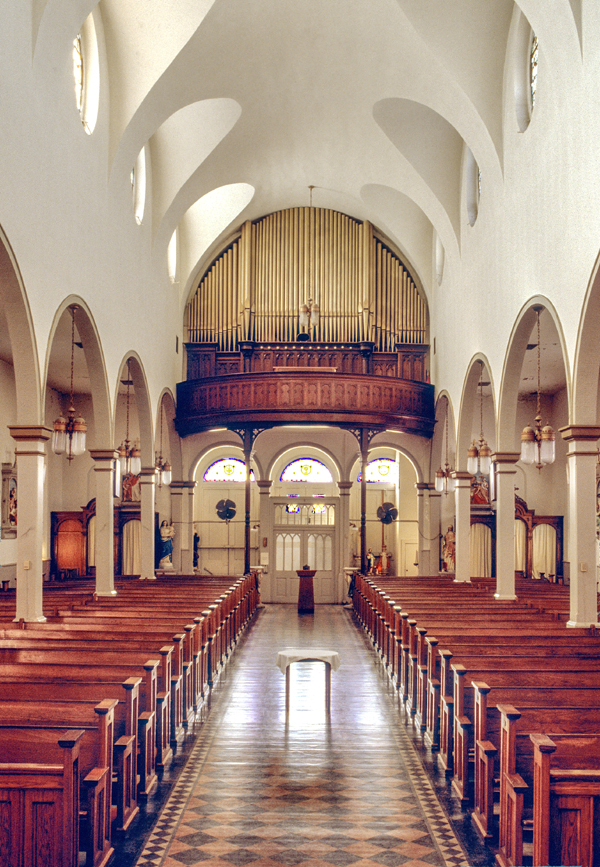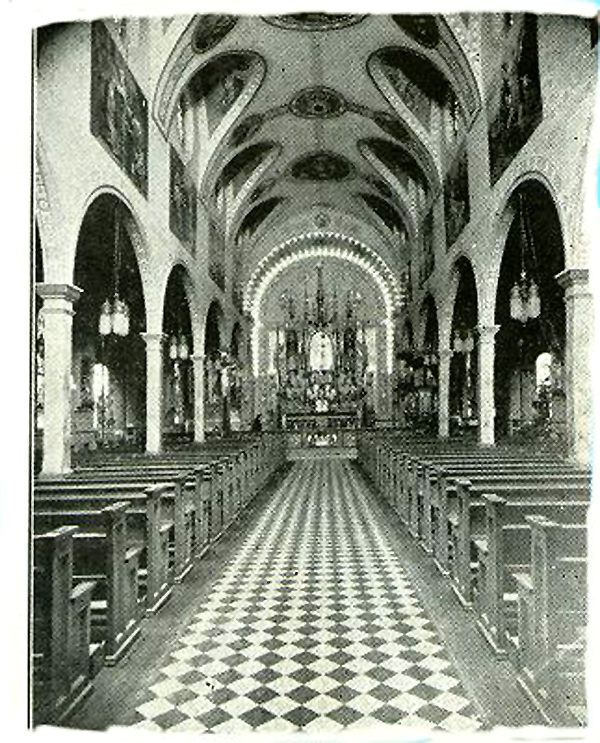714 St. Ferdinand Street, New Orleans, LA.
(Church Closed in 2001)
(Falling attendance and extensive termite damage to building forced closure)
NewOrleansChurches.Com®
Photography by John DeMajo and Kathleen DeMajo Adams
HOLY TRINITY CATHOLIC CHURCH 714 St. Ferdinand Street, New Orleans, LA. (Church Closed in 2001) |
Holy Trinity Church as it appears after
several years as a closed parish. This is a pre-Katrina photo (Falling attendance and extensive termite damage to building forced closure) |
 |
Interior of Holy Trinity Church, New Orleans, as it appeared in 1989. The Tellers and Sommerhof organ is visible in the choir loft at rear. Photo courtesy of William Van Pelt. |
HOLY TRINITY PARISH HISTORY |
In 1850, New Orleans was divided into three municipalities, The First Municipality, which was the Vieux Carre, The Second, which was the area above Canal Street, and the Third which was the downtown section. Each section was an extension of the settlements that eventually formed New Orleans. In the Third Municipality, the French had settled the area, which was originally the Fabourg Marigny. But further down river, many German settlers had taken up residence. Wherever these settlements were formed, they were usually given their own church, with sermons and other functions in the native language. In the Third Municipality, the French had been given Annunciation Church. The Germans wanted their own church, so Archbishop Antoine Blanc called upon the Redemptorists at St. Mary’s Parish to send the Rev. J.M. Masquelet to the Third District to organize a new German parish. On November 12, 1847, Father Masquelet purchased property at the corner of Dauphine and St. Ferdinand streets for $3000. He proceeded to build a church there and on June 1848, it was dedicated as the Holy Trinity Church. Later, Father Anthony Bolselaw Gendirowski succeeded Father Masquelet. He encountered difficulty and the church burned to the ground in 1851. The parishioners became divided and Fr. Gendirowski withdrew. Rev. Matthias Schifferer was assigned to reconstruct the parish and a new church was dedicated in May of 1853. Father Schifferer provided fifteen years of devoted service but he was the victim of a yellow fever epidemic and died on September 25 1866. Prior to his death, Fr. Schifferer added to the church property by purchasing eight additional lots on St. Ferdinand Street. The next pastor was Rev. Bernard Jeckel, a Capuchin Friar, who administered the parish until August 20, 1867 when Archbishop Odin appointed Rev. Ignatius Scheck as pastor and Rev. Peter Leonard Thevis as assistant. Fr. Scheck’s pastorate was short-lived as he also succumbed to Yellow Fever on June 24, 1868. Fr. Thevis was immediately appointed pastor and he directed the church through its most important formative years. In 1871, at Father Thevis’ invitation, the Benedictine Sisters sent several nuns from the motherhouse in Covington, Ky, to operate the school. Carl Weiss of Munich was called upon to be the organist and to teach the upper grades at the school. In 1871, Fr. Thevis built a school building on the lots that had been purchased by Fr. Schifferer. His entire congregation revered Father Thevis’s work. He Established the St. Roch Cemetery on land he bought from the heirs of Jack Phillips. It was dedicated on August 16, 1876. When he died on August 21, 1893, he was buried in the chapel of the Campo Santo (St.Roch Cemetery) that he had built. Several priests succeeded Thevis including Rev. Daniel Thevis, nephew of the previous Fr. Thevis, Rev. Anthony Bichelmier, And Rev. John Primm. Father Primm was another energetic priest who made a distinct mark on the parish. In 1910, he established the school as a free parochial school. He also established a chapel in Gentilly which would later become St. James Major Parish. Fr. Primm died in 1938 and he was succeeded by Rev, Herman Hammerstein and later by Fr. Magnus Roth. Fr. Roth was an energetic worker and he directed the church into the second half of the twentieth-century. |
 |
Interior of Holy Trinity Church ca: 1947
(Photo courtesy Centenary program of 1947)
|
VIEW A SPECIAL SERIES OF HOLY
TRINITY INTERIOR PHOTOGRAPHS
|
Specifications
for the Tellers-Sommerhof Organ Co. NOTE: After its removal, the organ went to Redman Organ Co. in Ft. Worth for refurbishment and intended installation in new St .Francis Xavier Church in Metairie. That installation has now been completed. Photos of the resulting instrument can be seen at this URL. |
|||
GREAT |
SWELL (Enc.) |
CHOIR (Enc.) |
PEDAL |
| Open Diapason 8 | Bourdon 16 | Violin Diapason 8 | Open Diapason 16 |
| Second Open Diapason 8 | Open Diapason 8 | Concert Flute 8 | Bourdon 16 |
| Viola Di Gamba 8 | Stop'd Diapason 8 | Viol d'Amour 8 | Lieblich Gedackt 16 |
| Gross Flute 8 | Salicional 8 | Wald Flute 4 | Violoncello 8 |
| Claribella 8 [sic] | Aeolina 8 [sic] | Saxaphone 8 | Trombone 16 |
| Octave 4 | Vox Celeste 8 | ||
| Flauto Traverso 4 | Flute Harmonique 4 | Couplers | |
| Tuba 8 | Piccolo Harmonique 2 | Swell to Pedal | |
| Carillon | Cornopean 8 | Great to Pedal | |
| Great Unison Off | Oboe 8 | Choir to Pedal | |
| Clarinet 8 | Swell to Great Sub Octave | ||
| Action: T-P to slider chests | Tremolo | Swell to Great | |
| Voices: 29 | Swell to Great Octave | ||
| Stops: 29 | Pedal Movements | Choir to Great | |
| Ranks: 29 | Swell Expression (bal.) | Swell to Choir | |
| Pipes: 1,602 | Choir Expression (bal.) | ||
| To see a detailed history of the organ, click here for a PDF document from the 1989 catalog of the Organ Historical Society convention at New Orleans. | |||